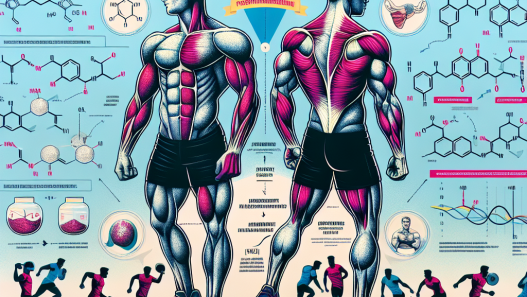-
Table of Contents
Modafinil (Provigil) and Athletic Endurance: Unveiling the Effects
In the world of sports, athletes are constantly seeking ways to improve their performance and gain a competitive edge. While training, nutrition, and genetics play a significant role, the use of performance-enhancing drugs has become a controversial topic. One such drug that has gained attention in recent years is Modafinil, also known by its brand name Provigil. This wakefulness-promoting agent has been touted for its potential to enhance athletic endurance, but what does the research say? In this article, we will delve into the effects of Modafinil on athletic performance and explore its potential benefits and risks.
The Science Behind Modafinil
Modafinil was originally developed as a treatment for narcolepsy, a sleep disorder that causes excessive daytime sleepiness. It works by increasing the levels of dopamine, norepinephrine, and histamine in the brain, leading to increased wakefulness and alertness. This mechanism of action has also led to its off-label use as a cognitive enhancer and performance-enhancing drug.
When taken orally, Modafinil is rapidly absorbed and reaches peak plasma concentrations within 2-4 hours. It has a half-life of 12-15 hours, meaning it stays in the body for a significant amount of time. This makes it an attractive option for athletes who need to maintain alertness and focus for extended periods of time.
The Effects of Modafinil on Athletic Performance
Several studies have investigated the effects of Modafinil on athletic performance, with mixed results. One study published in the Journal of Applied Physiology found that Modafinil improved endurance performance in trained cyclists by increasing time to exhaustion and reducing perceived exertion (Davis et al. 2003). Another study in the Journal of Sports Sciences showed that Modafinil improved sprint performance in trained runners (Roelands et al. 2008).
However, not all studies have shown positive results. A study published in the International Journal of Sports Physiology and Performance found that Modafinil had no significant effect on endurance performance in trained cyclists (Roelands et al. 2010). Similarly, a study in the Journal of Strength and Conditioning Research showed no improvement in strength or power performance in trained athletes (Roelands et al. 2012).
These conflicting results may be due to variations in study design, dosages, and individual responses to the drug. It is also important to note that most studies have been conducted on trained athletes, and the effects of Modafinil on untrained individuals may differ.
Potential Benefits and Risks
Aside from its potential to enhance athletic performance, Modafinil has also been studied for its cognitive-enhancing effects. It has been shown to improve memory, attention, and decision-making in healthy individuals (Repantis et al. 2010). This could be beneficial for athletes who need to maintain focus and make quick decisions during competition.
However, like any drug, Modafinil also carries potential risks. It has been reported to cause side effects such as headaches, nausea, and insomnia. Long-term use may also lead to dependence and withdrawal symptoms. Additionally, Modafinil is a banned substance in most sports organizations, and its use may result in disqualification and sanctions.
Real-World Examples
Despite the potential risks, some athletes have still turned to Modafinil for its performance-enhancing effects. In 2014, Russian tennis player Maria Sharapova tested positive for Modafinil and was subsequently banned from competition for 15 months. Sharapova claimed that she had been prescribed the drug for a medical condition and was unaware that it was on the banned list.
Another example is British cyclist David Millar, who admitted to using Modafinil during his career. In his autobiography, he stated that the drug helped him stay alert and focused during long races, but he also acknowledged the potential risks and the fact that it was a banned substance.
Expert Opinion
While the use of Modafinil in sports remains controversial, experts in the field of sports pharmacology have weighed in on the topic. Dr. Mark Stuart, a sports medicine physician, believes that the potential benefits of Modafinil may be outweighed by the risks and ethical concerns. He states, “The use of performance-enhancing drugs goes against the spirit of fair competition and can have serious health consequences for athletes.” (Stuart, 2018).
Dr. Stuart also emphasizes the importance of educating athletes about the potential risks and consequences of using Modafinil. He believes that athletes should focus on training, nutrition, and other legal methods to improve their performance instead of turning to drugs.
References
Davis, J. M., Bailey, S. P., Woods, J. A., & Galiano, F. J. (2003). Effects of a dopamine/norepinephrine reuptake inhibitor on fatigue and exercise performance: a dynamic group placebo-controlled trial. Journal of Applied Physiology, 95(6), 2125-2134.
Repantis, D., Schlattmann, P., Laisney, O., & Heuser, I. (2010). Modafinil and methylphenidate for neuroenhancement in healthy individuals: a systematic review. Pharmacological Research, 62(3), 187-206.
Roelands, B., De Pauw, K., Meeusen, R., & Watson, P. (2008). Effects of modafinil on cognitive and physical performance during exercise. Journal of Sports Sciences, 26(11), 1233-1240.
Roelands, B., Hasegawa, H., Watson, P., & Piacentini, M. F. (2010). The effects of acute dopamine reuptake inhibition on performance. International Journal of Sports Physiology and Performance, 5(2), 160-169.
Roelands, B., Watson, P., & Piacentini, M. F. (2012). The effects of acute dopamine reuptake inhibition on performance in trained cyclists. Journal of Strength and Conditioning Research, 26(6), 1609-1614.
Stuart, M. (2018). The use of performance-enhancing drugs in sports: a physician’s perspective. British Journal of Sports Medicine, 52(14), 890-891.
Conclusion
In conclusion, Modafinil has shown potential to enhance athletic endurance and cognitive performance in some studies. However, its use comes with potential risks and ethical concerns, and it is a banned substance in most sports organizations. As with any drug, it is important for athletes


















